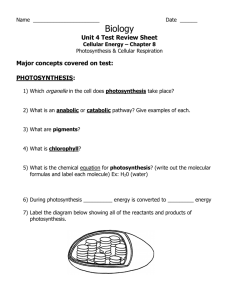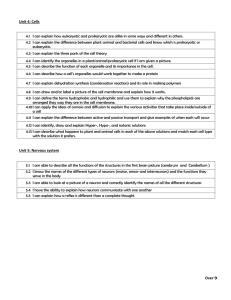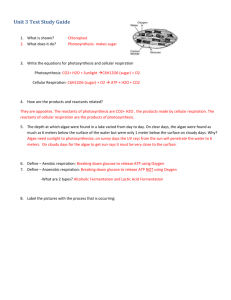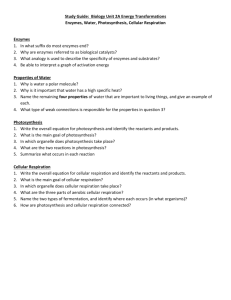unit 3 homework cellular energetics
advertisement
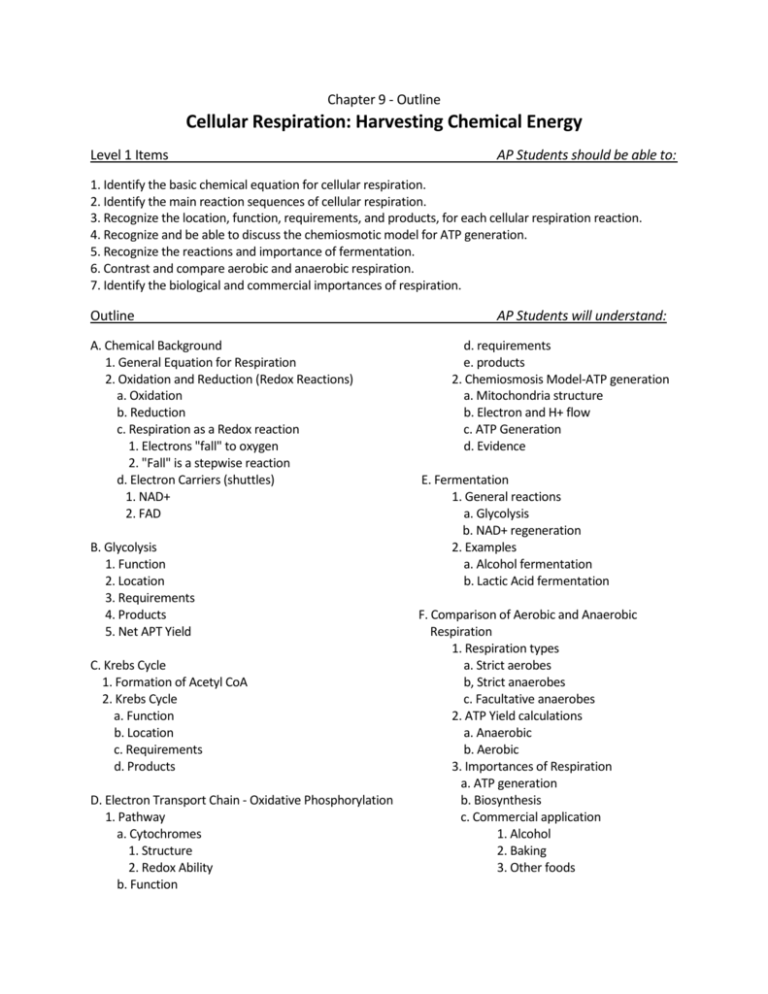
Chapter 9 - Outline Cellular Respiration: Harvesting Chemical Energy Level 1 Items AP Students should be able to: 1. Identify the basic chemical equation for cellular respiration. 2. Identify the main reaction sequences of cellular respiration. 3. Recognize the location, function, requirements, and products, for each cellular respiration reaction. 4. Recognize and be able to discuss the chemiosmotic model for ATP generation. 5. Recognize the reactions and importance of fermentation. 6. Contrast and compare aerobic and anaerobic respiration. 7. Identify the biological and commercial importances of respiration. Outline A. Chemical Background 1. General Equation for Respiration 2. Oxidation and Reduction (Redox Reactions) a. Oxidation b. Reduction c. Respiration as a Redox reaction 1. Electrons "fall" to oxygen 2. "Fall" is a stepwise reaction d. Electron Carriers (shuttles) 1. NAD+ 2. FAD B. Glycolysis 1. Function 2. Location 3. Requirements 4. Products 5. Net APT Yield C. Krebs Cycle 1. Formation of Acetyl CoA 2. Krebs Cycle a. Function b. Location c. Requirements d. Products D. Electron Transport Chain - Oxidative Phosphorylation 1. Pathway a. Cytochromes 1. Structure 2. Redox Ability b. Function AP Students will understand: d. requirements e. products 2. Chemiosmosis Model-ATP generation a. Mitochondria structure b. Electron and H+ flow c. ATP Generation d. Evidence E. Fermentation 1. General reactions a. Glycolysis b. NAD+ regeneration 2. Examples a. Alcohol fermentation b. Lactic Acid fermentation F. Comparison of Aerobic and Anaerobic Respiration 1. Respiration types a. Strict aerobes b, Strict anaerobes c. Facultative anaerobes 2. ATP Yield calculations a. Anaerobic b. Aerobic 3. Importances of Respiration a. ATP generation b. Biosynthesis c. Commercial application 1. Alcohol 2. Baking 3. Other foods Chapter 9 – Homework Cellular Respiration: Harvesting Chemical Energy – Homework 1. Write the basic balanced equation for cellular respiration. 2. In the conversion of glucose and oxygen to carbon dioxide and water, which molecule is reduced? Explain how you know. Which molecule is oxidized? Explain how you know. 3. Construct a table showing the three main reactions of cellular respiration. For each reaction show the following information: a. location in the cell, b. function of reaction, c. input/requirements, d.output/products. 4. Go back to question 1 and look at the balanced equation for Rs (respiration). Identify which of the three reactions of cellular respiration each part of your equation is from. (e.g. which reaction has glucose as a requirement etc.) 5. Explain why the energy investment phase of Glycolysis is necessary. 6. Describe the role of oxygen in cellular respiration. 7. Contrast and compare substrate-level phosphorylation versus oxidative phosphorylation. Identify in which stage of cellular respiration each occurs. 8. Discuss why Glycolysis is considered to be one of the first metabolic pathways to have evolved. 9. Speculate the adaptive value is of having ATP synthase in the inner membrane instead of the outer membrane of the mitochondria. 10. Consider a liver cell (high metabolic rate) and a fat cell (low metabolic rate). Discuss how these two cells types will likely compare in terms of the number of mitochondria per cell. Compare the structure of their mitochondria as well. 11. Why is the process of chemiosmosis also called a “proton-motive force”? 12. What is the adaptive value of fermentation? If given a choice, would a yeast cell “prefer” to conduct fermentation or cellular respiration? Explain. Chapter 10 – Outline Photosynthesis Level 1 Items AP Students will should be able to: 1. Identify the basic equation of Photosynthesis. 2. Identify the main reactions of Photosynthesis. 3. Recognize the function, location, requirements and products of the Photosynthesis reactions. 4. Recognize the role of light and pigments in the Photosynthesis process. 5. Recognize the effects and importance of Photorespiration. 6. Recognize various types of Photosynthesis and their importances. 7. Identify the biological and economic importances of Photosynthesis. Outline A. How Plants Make Food (Autotrophs) 1. General Equation for Photosynthesis 2. The Splitting of Water a. Model b. Evidence c. Ps as a Redox Process 3. The Two Stages of Photosynthesis (an Overview) a. Light Reaction b. Calvin Cycle (Dark Reaction) AP Students will understand: C. How the Calvin Cycle Makes Sugar 1. Function 2. Location 3. Requirements 4. Products 5. Pathway D. Photorespiration 1. Rubisco 2. Importance B. Light Reaction E. C4 Plants – a Ps variation 1. Nature of Light 1. History a. Electromagnetic Spectrum 2. Anatomy b. Visible Light a. Mesophyll Cells c. Photosynthetic Wavelengths b. Bundle Sheath Cells 3. Pathway 2. Photosynthetic Pigments a. PEP Carboxylase a. Chlorophyll b. Calvin Cycle 1. Structure and Elemental Composition 4. Examples 2. Types 5. Growth Characteristics b. Accessory 1. Function F. CAM Plants – another Ps variation 2. Examples 1. History a. Carotenoids 2. Pathway b. Xanthophyll a. Day b. Night 3. Photosystems 3. Examples a. Definition 4. Growth Characteristics b. Types 1. Photosystem I G. Photosynthesis and Respiration Ratios 2. Photosystem II 1. Ps > Rs, growth and reproduction 4. Cyclic Electron Flow – How to make a bunch of ATP 2. Ps = Rs, equilibrium a. Pathway 3. Ps < Rs, death by starvation b. Function 5. Noncyclic or Linear Electron Flow – How to make ATP and NADPHH. Factors that Affect Photosynthesis 1. Light a. Function 2. CO2 levels b. Location 3. Temperature c. Requirements 4. Minerals d. Products e. Pathway I. Importances of Photosynthesis f. Chemiosmotic Model 1. Food 2. Oxygen 3. CO2 Balance 4. Plant Products 5. Life of Earth Chapter 10 –Homework Photosynthesis 1. Write the basic equation for Photosynthesis (Ps). 2. Some students define Ps as the process by which plants use light energy as food. Discuss if this is a correct statement -would it likely be accepted by an AP Biology Exam Reader? 3. Contrast and compare an absorption spectra (spectrum) versus an action spectra (spectrum) for Ps. 4. Discuss why the narrow area of electromagnetic radiation between 380-750 nm is the best choice to power a process like Ps. 5. Contrast and compare the function of chlorophyll pigments versus the function of the accessory pigments in Ps. 6. Explain the adaptive value of plants having their leaves change color in the fall. 7. Contrast and compare the tasks or purposes of the Light Reaction and Dark Reaction. 8. During the light reaction the proton gradient across the thylakoid membrane can be as great as 3 pH units. On which side of the membrane (stroma or lumen of the grana) is the pH the lowest (which way are the H+ moving into)? 9. Photorespiration costs the plant as much as 50% of the carbon fixed in the Calvin Cycle. Discuss why this process has not been selected against (or has it?). 10. Discuss under what environmental conditions C4 Ps and CAM Ps are adaptive. 11. In science fiction stories, plants that live on planets far from the sun are often described as having black foliage, while those that live on planets close to the sun are described as having shiny reflective foliage. Discuss why these would be good adaptive features.



